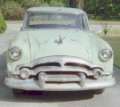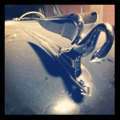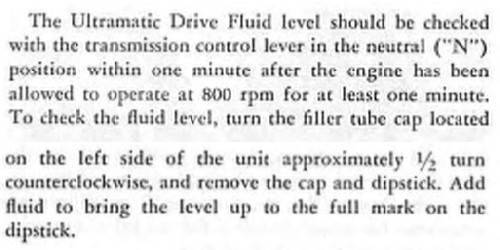|
Re: 1951 (24 Series) Ultramatic Leak
|
||||
|---|---|---|---|---|
|
Forum Ambassador
|
Not normal to leak over the winter any differently than other times but having said that, there are seals that can leak from just sitting. The ones around the throttle and selector shafts are prime examples. Oil pan gasket is another. Maybe they can shrink more in cold weather but then fluid is thicker too. Can you tell by a puddle on the floor if one of those might be the cause. If not, then the front and rear seal would be the ones that tend to leak mostly during use. Any other places would be a matter of close examination.
The dipstick can only be accessed from under the car on 51s. The 50 had a large plate that could be removed (a big undertaking) but that was eliminated with the new bodies. Due to the location, believe a couple of people who contemplated cutting a hole were not successful. The fluid can be added from the top. You have to move the seat all the way back and then fold the carpet (best from passenger side) over to clear the area of hump just in front of the seat. There is a metal plate screwed to the hump and directly under that is the vent opening. Fluid can slowly be added there. Normally the vent has a pressed on loose fitting cap with a mesh under. You can remove those and replace when done or unscrew the entire vent. Still have to crawl under to get to the dipstick though.
Posted on: 2012/6/19 14:02
|
|||
|
Howard
|
||||
|
||||
|
Re: 1951 (24 Series) Ultramatic Leak
|
||||
|---|---|---|---|---|
|
Home away from home

|
Speaking of adding the transmission fluid inside the passenger compartment through the transmission hump hole, if yours is like my 53, you have in the hole first steel mesh looking like part of a kitchen potscrubber steel wool pad (minus the soap, of course), and then underneath that a circular mesh filter placed in the hole. First remove the steel mesh. Then remove the circular mesh filter from the hole using a tweezer. If you remove them both, transmission fluid will go in a lot faster. My experience with my car. Hope that helps!
Ken Edit: Don't forget to put both back in after you are done adding fluid.
Posted on: 2012/6/21 11:53
|
|||
|
||||
|
Re: 1951 (24 Series) Ultramatic Leak
|
||||
|---|---|---|---|---|
|
Just can't stay away

|
I have a 25th series Patrician 400 that has been sitting for the past 8 weeks or so (I've been making some repairs under the hood), and having never leaked before, all of a sudden I started noticing transmission fluid on the ground. First a little bit, and then, as the weeks wore on, more and more. I got under the car this evening to pull the dipstick and found fluid dripping out of the dipstick hole the moment I loosened it -- indeed, the fluid was up to the top of the fill hole and had been leaking out (slowly) from the dipstick. It turns out that when the ultramatics sit for several weeks, particularly if the have some miles on them (mine has 40k on it), the torque converter starts to drain back into the pan over time. If you keep the transmission topped up to the full level on the dipstick, having the converter drain back into the pan will result in overflowing. The solution is to either run the car regularly (even just starting the car and running it in park will cause the pump to re-fill the converter), or to let the fluid leak out and then start the engine, check the level, and refill to the correct level once you're ready to start driving your car again.
Posted on: 2012/9/12 2:44
|
|||
|
||||
|
Re: 1951 (24 Series) Ultramatic Leak
|
||||
|---|---|---|---|---|
|
Forum Ambassador
|
That shouldn't be an issue. Converter fluid has returned to case within a very short time after engine stopped since elimination of a check valve during early production. Perhaps an incorrect procedure was used to check level at some point and trans became overfilled. Here is Packards recommendation.
Posted on: 2012/9/12 8:59
|
|||
|
Howard
|
||||
|
||||
|
Re: 1951 (24 Series) Ultramatic Leak
|
||||
|---|---|---|---|---|
|
Home away from home

|
Howard, I'm assuming that the procedure to check the '51 is the same as my '54? And that it should be done while the car is running?
I would never just 'fill it up' as in 'pour it in until it overflows'. Automatic transmissions work on the principles of hydraulic pressure, controlled friction/slippage, etc., and 'Overfilling' as you car seems, risks entirely too much internal pressure which not only could account for the leaks you see, but internal trans damage as well. It's inconvenient, but you really do need to crawl under there and properly check (and then add) the right amount of correct fluid.
Posted on: 2012/9/12 10:28
|
|||
|
1954 black Patrician, unrestored, mostly original, minty!!
|
||||
|
||||
|
Re: 1951 (24 Series) Ultramatic Leak
|
||||
|---|---|---|---|---|
|
Forum Ambassador
|
Believe the recommended procedure has been the same on all regular Ultras since the check valve was removed during the 23rd series production. For those early ones having the valve it was check within 5 minutes.
While I think there was an early mention of check with engine running and some probably do, guess others were uncomfortable either crawling under a running car or having it running while going up on a lift so the time limit. Don't believe the owners manual even mentions how to check other than do it every 1000 miles. Guess they didn't expect a Packard owner to crawl under and just figured they'd head to the dealer.
Posted on: 2012/9/12 10:58
|
|||
|
Howard
|
||||
|
||||
|
Re: 1951 (24 Series) Ultramatic Leak
|
||||
|---|---|---|---|---|
|
Home away from home

|
Thanks, Howard..I've always checked it running, in neutral. One of the true mysteries is why the worlds most competent engineers would spec an itty bitty dipstick waaaay up there where the sun never shines...
Posted on: 2012/9/12 15:00
|
|||
|
1954 black Patrician, unrestored, mostly original, minty!!
|
||||
|
||||
|
Re: 1951 (24 Series) Ultramatic Leak
|
||||
|---|---|---|---|---|
|
Not too shy to talk

|
Can the seals around the throttle and selector shaft be replaced without removing the transmission oil pan?
Posted on: 2014/9/16 6:58
|
|||
|
||||
|
Re: 1951 (24 Series) Ultramatic Leak
|
||||
|---|---|---|---|---|
|
Forum Ambassador

|
Can the seals around the throttle and selector shaft be replaced without removing the transmission oil pan?
Yes. Various techniques to remove them, I've drilled two small holes about 180 deg. apart and inserted self-tapping screws partway to apply leverage and pry them out. The recess may be deep enough to actually leave the existing seal in place and simply press in a new one on top of the old one.
Posted on: 2014/9/16 7:21
|
|||
|
||||

 (23.86 KB)
(23.86 KB)








